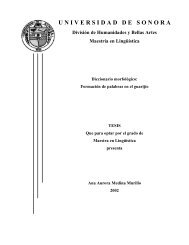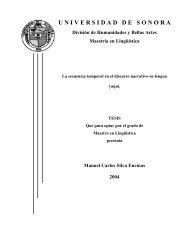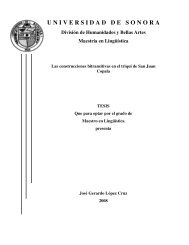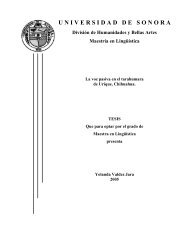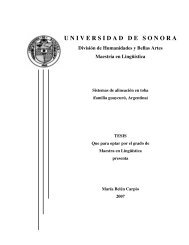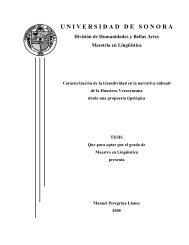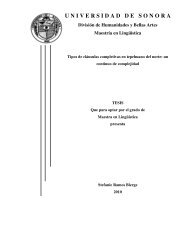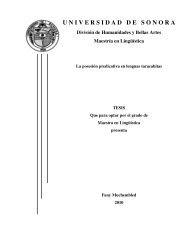Seminario de complejidad sintáctica 2006 - Maestría en Lingüística ...
Seminario de complejidad sintáctica 2006 - Maestría en Lingüística ...
Seminario de complejidad sintáctica 2006 - Maestría en Lingüística ...
Create successful ePaper yourself
Turn your PDF publications into a flip-book with our unique Google optimized e-Paper software.
The English resultative construction (Goldberg 1995, Boas<br />
2003, Goldberg & Jack<strong>en</strong>doff 2005) is characterized by a verb<br />
phrase that expresses manner, an object, and a resultative<br />
phrase (RP). The RP is a prepositional or adjectival phrase<br />
expressing path or result as shown in (1). The object of the<br />
verb is shared as an argum<strong>en</strong>t of the RP. The syntax of the<br />
construction prev<strong>en</strong>ts anything other than manner or path<br />
being expressed in the RP and no construction exists with the<br />
same semantics with manner expressed in two predicates modifying<br />
the same object (2).<br />
The serial verb construction in Kuki-Thadow, by <strong>de</strong>finition,<br />
has a differ<strong>en</strong>t syntax but it shares the property that the<br />
object of one of the verbs serves as the subject of the other<br />
(3). In KT, there are restrictions on what two verbs can be<br />
combined together into a serial verb construction. In motion<br />
predicates, only one verb may reflect manner or path and in<br />
other constructions, the second verb must reflect a result (4).<br />
The two constraints are related to each other and both have<br />
a functional grounding in the motion verb typology of Talmy<br />
(1985). Talmy suggests that for motion predications, any one<br />
sc<strong>en</strong>e can have one expression of manner, which is marked on<br />
either the verb or satellite and one expression of path, marked<br />
on the other, <strong>de</strong>p<strong>en</strong>ding on language. Thus any complex motion<br />
predicate can only have one expression of manner and<br />
one of path (Goldberg 1991). The ev<strong>en</strong>t structure metaphor<br />
(Lakoff & Johnson 1999) allows the ext<strong>en</strong>sion of this constraint<br />
from paths to results, obtaining the constraint found in<br />
the two languages.<br />
This account of the constraint on complex predication in<br />
two differ<strong>en</strong>t languages and two differ<strong>en</strong>t syntactic constructions<br />
suggests another way that complex prediction can be<br />
se<strong>en</strong> as a unitary ph<strong>en</strong>om<strong>en</strong>on. It also invites further investigation<br />
on cross-linguistic constraints on complex predicates.<br />
The functional grounding and metaphoric ext<strong>en</strong>sion also provi<strong>de</strong><br />
an explanation for a constraint that would otherwise be<br />
arbitrary.<br />
25



